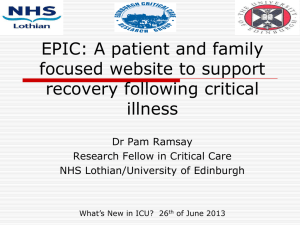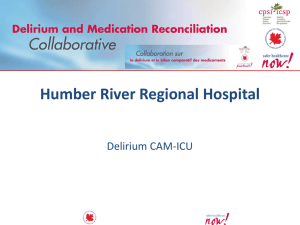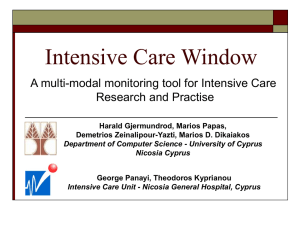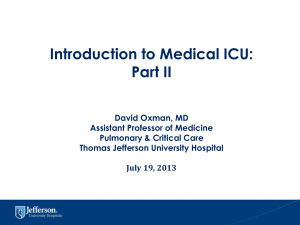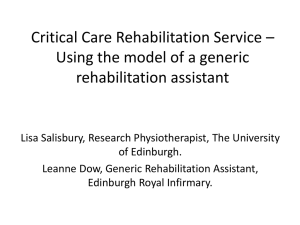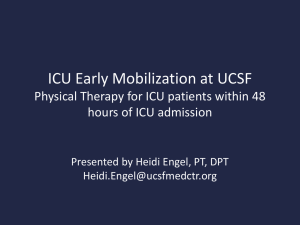Early Rehabilitation for Patients Who are Critically Ill
advertisement
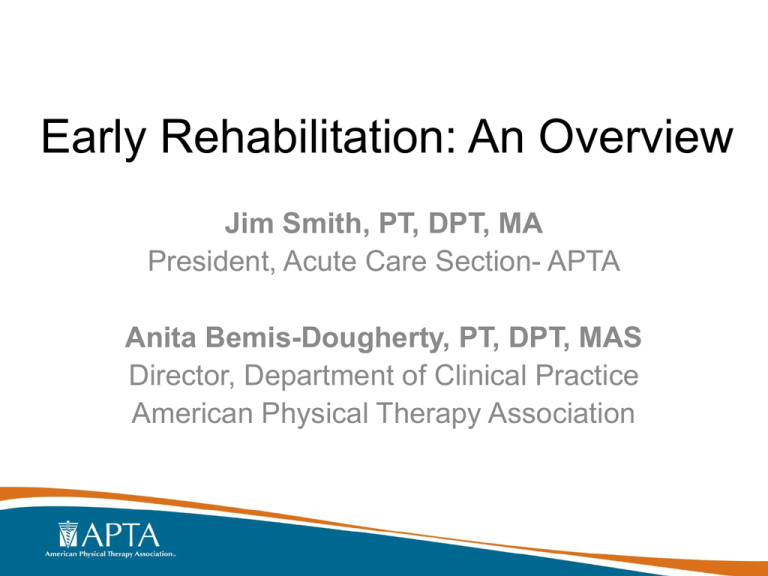
Early Rehabilitation: An Overview
Jim Smith, PT, DPT, MA
President, Acute Care Section- APTA
Anita Bemis-Dougherty, PT, DPT, MAS
Director, Department of Clinical Practice
American Physical Therapy Association
APTA
• The American Physical Therapy Association (APTA)
is a professional organization representing more than
88,000 member physical therapists (PTs), physical
therapist assistants (PTAs), and students of physical
therapy. APTA seeks to improve the health and quality
of life of individuals in society by advancing physical
therapist practice, education, and research, and by
increasing the awareness and understanding of
physical therapy's role in the nation's health care
system. For more information go to: www.apta.org
• The Acute Care Section- APTA has a mission to
foster excellence in acute care practice, in all settings,
in order to enhance the health and functioning of
patients and clients. www.acutept.org
Polling question: Patients on a ventilator are
critically ill and the documented risks from
early rehabilitation and mobilization include:
A. Delirium and increased agitation
B. Increased occurrence of falls
C. Inadvertent extubation or disconnection of
lines
D. All of the above
E. None of the above
Overview
• What is early rehab?
– Demonstration
• Interprofessional
teamwork
• Problems associated
with critical illness
• Benefits from early
rehabilitation
• Which patients are
appropriate?
– Screening algorithm
• What interventions
are appropriate?
• Getting started
• Overcome barriers
• CUSP 4 MVP-VAP
roll-out
• Value
• Questions
What is it?
“ICU early mobility… is a preventative form of physical
and cognitive rehabilitation, engaging the critically ill
person in activity that assists with recovery of the
cardiopulmonary system, prevents muscle
deterioration and joint contractures, and begins
restoration of autonomy. This engagement can be a
labor-intensive process, but the early initiation of daily
activity – preferably at the beginning of a patient’s ICU
stay – pays off for the patient with greater physical
independence, greater chance of discharge to home
rather than to a skilled nursing facility, and lower rates
of delirium.” http://www.iculiberation.org/Mobility/Pages/default.aspx
Video
http://www.youtube.com/watch?v=JXBbaR1PQu0
Interprofessional Teamwork
• Collaboration is essential
• Physical & occupational therapists need to
engage in building relationships in the ICU
• Common interest in meaningful outcomes
– Decrease length of stay
– Decrease readmissions
– Improve patient outcomes & satisfaction
Polling question: The problems that
accompany several days in an ICU are due
to deconditioning and will resolve with rest
and routine rehabilitation after discharge
from the ICU.
A. True
B. False
Problems Associated with
Critical Illness
• When deconditioning and muscle weakness
occur the course becomes complicated, the
stay in the ICU is prolonged, and mortality
increases
• Risk developing ICU-associated weakness
due to polyneuropathy, myopathy, or a
combination of both
• The cumulative effect of the complications
are functional limitations that might or might
not resolve.
Potential body/structure effects of critical illness
Nordon-Craft A, Moss M, Quan D, Schenkman M: Intensive care unitacquired weakness: Implication for physical therapist management. Phys
Ther. 2012; 92:1494-1506.
“The complications experienced by ICU
survivors include deterioration of strength,
physical abilities, and psychological abilities.
The persistence of symptoms such as reduced
ability to perform activities of daily living,
reduced capacity for ambulation, depression,
posttraumatic stress syndrome, and anxiety
contributes to an adverse effect on the
individual’s quality of life and long-term
survival. ‘Post–intensive care syndrome’
(PICS) is the preferred designation for this
constellation of complications that endure well
past the stay in the ICU.”
Bemis-Dougherty AR, Smith JM. What follows survival of critical illness? Physical therapists’
management of patients with post–intensive care syndrome. Phys Ther. 2013;93:179–185.
Benefits of Early
Rehabilitation in the ICU
• Benefits to patients
• Financial benefits
• Feasible and safe
Benefits to patients
•
•
•
•
•
•
Preserve muscle strength
Improve functioning
Promote weaning from ventilator
Decrease length of stay in ICU
Decrease length of stay in hospital
Improve quality of life
Financial Benefits
• Due to decrease in the length of stay in
ICU and hospital
– For elegant modeling and analysis refer to
Lord RK, Mayhew CR, Korupolu R, et al. ICU
early physical rehabilitation programs:
Financial modeling of cost savings. Crit
Care Med. 2013;41:717-724.
– Example net savings > $800,000 / year
Feasible and Safe
• There is low risk for harm from early rehab
• There is risk of harm without early rehab
• Recommended resources
– Barr J, Fraser GL, Puntillo K, et al. Clinical practice guidelines for the
management of pain, agitation, and delirium in adult patients in the
intensive care unit. Crit Care Med. 2013;41(1):263-306.
– Li Z, Peng X, Zhu B, Zhang Y, Xi X. Active mobilization for mechanically
ventilated patients: A systematic review. Arch Phys Med Rehabil.
2013;94:551-561.
– Morris PE, Goad A, Thompson C, et al. Early intensive care unit mobility
in the treatment of acute respiratory failure. Crit Care Med.
2008;36:2238-2243.
Which Patients are Appropriate?
ICU patients who demonstrate:
• Mental alertness and ability to follow
simple commands
• Hemodynamic stability
• Adequate respiratory status with
acceptable levels of oxygen saturation
• Risk of complications that could be
prevented with exercise or activity
Medical screening
algorithm to evaluate
patient appropriateness
for rehabilitation
Can this patient engage and participate
in early rehabilitation?
Does my patient have the physiologic capacity
to participate in early rehabilitation?
What Interventions are
Appropriate?
• Planning interventions for a
heterogeneous population requires
rigorous clinical decision-making
What Interventions are Appropriate?
• Rehabilitation interventions should be
directed at improving impairments (eg,
insufficient aerobic capacity, weakness) and
activity limitations (eg, inability to transfer
out of bed or to ambulate)
• Exercise principles to guide interventions
– SAID
– Overload
What Interventions are Appropriate?
Strategies for Exercising and Mobilizing Patients:
• The intensity, duration, and frequency of
interventions are individually determined for
each patient and titrated based on the
response to an activity
– Safety is elevated by access to data about the
patient's response and use of thresholds for
exercise termination
– Decision-making is integral to dosing exercise
intensity
– Garzon-Serrano J, Ryan C, Waak K, et al. Early mobilization in critically ill patients:
Patients’ mobilization level depends on health care provider’s profession. PM&R.
2011;3(4):307-313.
Getting Started
• Cultures differ among ICUs
– Even within a hospital
• Recommendation – identify a rehabilitation
contact person for each ICU
– Recognition improves collaboration and trust
between the ICU team and the rehab provider
• Examples for participating as a part of the ICU
team: increased presence in unit, attendance
at meetings, rounds and training sessions
Zanni JM, Needham DM. Promoting Early Mobility
and Rehabilitation in the Intensive Care Unit. PT in
Motion. 2010;2(4):32-38.
Getting Started
• Successful teams develop shared goals,
measure their effectiveness, and have
shared accountability for desired patient
outcomes
– Interprofessional collaboration and
engagement with the patient / family are
essential
Polling question: What are the barriers to the
implementation of early rehabilitation and
mobilization of patients in the ICU:
A. Insufficient evidence to justify the
interventions
B. Deep sedation of patients
C. High cost of implementation
D. All of the above
E. None of the above
Potential Barriers
•
•
•
•
Lack of leadership
Lack of resources
Over-sedation and delirium
Staff concerns about the safety of
early mobilization
• Lack of clinical training to mobilize
critically ill patients
CUSP for MVP-VAP Key Mobility
Interventions
• Multi-disciplinary and coordinated approach
• Daily sedation interruption and minimizing
sedative use
• Structured assessments of sedation level
and delirium using sedation and delirium
scales.
• Screening for eligibility for mobilization
• Employing a nurse-driven protocol to
achieve highest level of mobility
CUSP for MVP-VAP Mobility
Reports
•
•
•
•
•
•
•
•
•
Distribution of highest level of mobility
% of RASS/SAS actual as being {-1, 0, 1} or {4, 5}
% of achieving RASS/SAS target
Delirium assessment compliance rate
% of CAM-ICU negative or ASE <=2 (no delirium)
% of patient days mobilized out of bed
Distribution of perceived barriers
Adverse event incidence rate
Adverse event rate (patient-day level)
In the Pipeline
• CUSP for MVP-VAP Early Mobility Toolkit
• Data facilitator call: Daily Early Mobility Data
Collection Training on May 14th 2014
• Content call: Early Mobility: A Practical
Approach on Aug 5th 2014
– Any teams willing to share?
• Homework: identify 3 barriers to mobilizing
patients and use action plan template to
address these
Value
“Potential benefits for patients participating in
early rehabilitation in the ICU include improved
muscle strength, physical function, and quality
of life. In addition, early rehabilitation programs
may be associated with reduced hospital and
ICU length of stay (LOS), duration of
mechanical ventilation, and hospital costs.”
– Parker AM, Sricharoenchai T, Needham DM. Early Rehabilitation in
the Intensive Care Unit: Preventing Impairment of Physical and
Mental Health. 2013. Curr Phys Med Rehabil Rep. Dec;1(4):307-314.
“A patient on a ventilator riding a
stationary bike or ambulating in the ICU
is perhaps the most powerful image in
the shifting paradigm of increased
mobility in this setting. A culture that
expects this level of activity - in contrast
to a tradition that encourages bedrest
and sedation - is the greatest challenge
to improving outcomes.”
– Smith J. Mobility lost in the ICU [Spotlight]. AHRQ WebM&M
[serial online]. October 2011. Available at:
http://www.webmm.ahrq.gov/case.aspx?caseID=251.
Questions?
Recommended Resources
• SCCM’s ICU Liberation project
(http://www.iculiberation.org)
– Early Mobility resources include documents, suggested
readings and videos
• APTA’s PTNow (http://www.ptnow.org) clinical
summary on “Critical Illness: Managing Patients in
the Intensive Care Unit”
– Includes recommendations for examination &
intervention and contains resources (eg, video)


